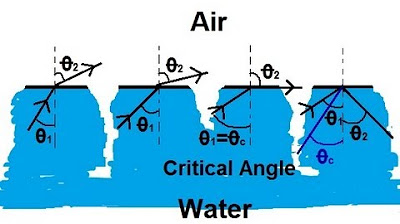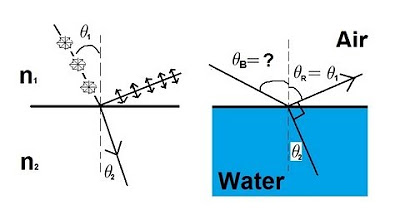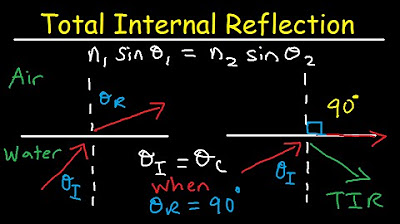Why Can't You Focus Underwater? | Physics with Professor Matt Anderson | M28-05
TLDRThe script explains the difficulty in focusing underwater without a mask due to the near-identical refractive indices of water and the cornea, which prevents light from bending properly to focus on the retina. It illustrates how Snell's Law dictates light bending at the air-cornea interface, which is disrupted when submerged in water. The solution is to reintroduce an air-water interface, typically achieved by wearing a diving goggles, to allow light to bend and focus correctly, enabling clear underwater vision.
Takeaways
- 👀 The human eye struggles to focus underwater because the light rays coming from objects, like fish, are not properly bent to focus on the retina.
- 🔍 The cornea plays a crucial role in bending light rays to focus them on the retina, and this bending is affected by the difference in the index of refraction between air and the cornea.
- 🌊 Underwater, the index of refraction of water is very similar to that of the cornea, which means light rays do not bend significantly when entering the eye, resulting in blurry vision.
- 📚 Snell's Law explains the bending of light rays at interfaces with different indices of refraction, such as from air to cornea.
- 💧 The cornea's index of refraction is nearly the same as water because the human body, including the cornea, is mostly composed of water.
- 🤿 To see clearly underwater, an air-water interface is needed, which is provided by wearing a diving mask that creates a small pocket of air in front of the eyes.
- 🐠 The purpose of a diving mask is to allow light to bend properly at the air-cornea interface, enabling the eyes to focus on underwater objects.
- 🏠 An alternative to a mask could be creating an air gap, such as putting a bucket over one's head, to provide the necessary air-water interface for clear underwater vision.
- 🔬 The script uses the analogy of a fish's appearance underwater to explain the scientific principles behind the focusing mechanism of the human eye.
- 🎨 The explanation includes visual aids, such as drawings of the eyeball and light rays, to help illustrate the concepts of refraction and focusing.
- 🧠 The script encourages the audience to think about the biological and physical reasons behind the cornea's properties and their impact on underwater vision.
Q & A
Why does the fish appear blurry when looking at it underwater without a mask?
-The fish appears blurry because the light rays coming from the fish do not bend enough at the cornea due to the similar index of refraction between water and the cornea, which prevents them from focusing properly on the retina.
What is the role of the cornea in focusing light rays?
-The cornea acts as the first interface where light rays coming into the eye bend. This bending is crucial for focusing the light on the retina at the back of the eyeball.
What is Snell's Law and how does it relate to vision underwater?
-Snell's Law states that the ratio of the sines of the angles of incidence and refraction is equal to the ratio of the indices of refraction of the two media. It relates to vision underwater because the similar indices of refraction between water and the cornea result in minimal bending of light rays, leading to blurry vision.
Why is the index of refraction of the cornea nearly the same as that of water?
-The cornea's index of refraction is nearly the same as water because the cornea, like the rest of the human body, is largely composed of water, which affects its optical properties.
How does wearing a diving mask improve underwater vision?
-A diving mask improves underwater vision by creating an air-water interface in front of the eyes. This allows light rays to bend at the air-cornea interface, enabling them to focus properly on the retina.
What would happen if you put a bucket over your head before submerging underwater?
-If you put a bucket over your head before submerging, you create an air gap between the water level and your eyes. This air gap allows light rays to bend properly at the air-cornea interface, improving your underwater vision.
What is the significance of the air gap in the context of underwater vision?
-The air gap is significant because it provides the necessary interface for light rays to bend as they enter the eye from the water, allowing for clear focus and vision underwater.
How does the shape of the cornea contribute to the bending of light rays?
-The cornea's curved shape causes the parallel light rays to bend inward towards their relative normals, which is essential for focusing the light on the retina.
What would be the consequence of having a cornea with a different index of refraction than water?
-If the cornea had a significantly different index of refraction than water, light rays would bend more at the cornea-water interface, potentially allowing for better focus and clearer vision underwater.
Can you explain the concept of the index of refraction and its importance in vision?
-The index of refraction is a measure of how much light slows down and bends when it passes from one medium to another. It is important in vision because it determines how much light rays bend at the interfaces between different media, such as air and the cornea, affecting the focus of the light on the retina.
Why is it difficult to see clearly underwater without any optical aid?
-It is difficult to see clearly underwater without an optical aid because the similar indices of refraction between water and the cornea result in minimal bending of light rays, preventing proper focus on the retina and causing blurry vision.
Outlines
👀 Understanding Blurry Vision Underwater
This paragraph explains why our vision becomes blurry underwater. It starts by setting the scene of swimming without a mask and the difficulty of seeing clearly. The explanation then delves into the science of light refraction, highlighting the role of the cornea and Snell's Law. The difference in the index of refraction between air and the cornea is what allows light to focus on the retina, but underwater, the similar index of refraction between water and the cornea prevents this bending, leading to blurry vision. The paragraph concludes by suggesting that our bodies are mostly water, which is why the cornea's index of refraction is similar to water, affecting our ability to see clearly.
🤿 The Solution to Blurry Underwater Vision: Using a Mask
The second paragraph addresses the solution to the problem of blurry vision underwater, which was introduced in the first paragraph. By wearing a diving mask, an air-water interface is created in front of the eyes, allowing light rays to bend at the air-cornea interface and focus properly on the retina. The paragraph humorously suggests that a mask isn't the only solution; any method that provides an air gap, such as a bucket over the head, can also solve the problem. This approach helps to understand the importance of the air gap in facilitating clear underwater vision.
Mindmap
Keywords
💡Focus
💡Underwater
💡Eyeballs
💡Blurry vision
💡Cornea
💡Snell's Law
💡Index of refraction
💡Air-water interface
💡Mask
💡Retina
💡Gelatinous
Highlights
The human eye struggles to focus underwater without a mask due to the refractive properties of light.
Light rays from an object underwater appear blurry because of the way they bend at the cornea.
The cornea bends light rays due to Snell's Law, which relates the angles of incidence and refraction to the indices of refraction of two media.
The index of refraction of the cornea is similar to that of water, which minimizes the bending of light rays and causes focusing issues.
The human body, being mostly water, may contribute to the cornea's similar index of refraction to water.
Wearing a mask creates an air-water interface that helps light rays bend correctly and focus on the retina.
A mask provides a pocket of air in front of the eyes, facilitating the bending of light rays for clear underwater vision.
An alternative to a mask is creating an air gap, such as with a bucket over the head, to achieve clear underwater vision.
The importance of the air gap in allowing the eye to focus light properly underwater is highlighted.
The role of the cornea's curvature in bending light rays towards their relative normals is explained.
The difference in the index of refraction between air and the cornea is crucial for focusing light on the retina.
Parallel light rays need to bend at the cornea to focus correctly at the retina's back.
The concept of Snell's Law is used to explain why light bends when transitioning from one medium to another.
The nearly identical indices of refraction between water and the cornea result in minimal light bending underwater.
The practical solution of using a diving mask to correct underwater vision by reintroducing an air interface.
The theoretical and practical implications of refraction and the human eye's adaptation to different environments.
The humorous example of using a bucket to create an air gap for clear underwater vision without a mask.
Transcripts
Browse More Related Video

Human Eye - Passage of light through it | Don't Memorise

Refraction Explained

Physics 52 Refraction and Snell's Law (4 of 11) Total Internal Reflection: From Water to Air

Physics 53 Polarization (5 of 5) Brewster's Angle

Total Internal Reflection of Light and Critical Angle of Refraction Physics

Snell's Law & Index of Refraction Practice Problems - Physics
5.0 / 5 (0 votes)
Thanks for rating: